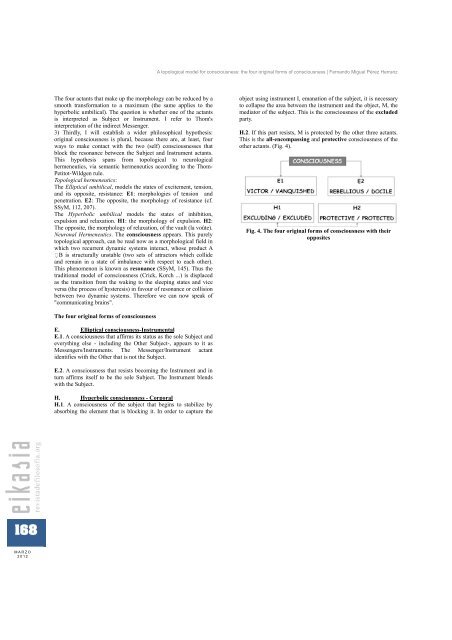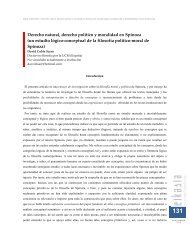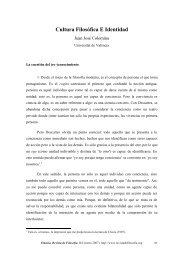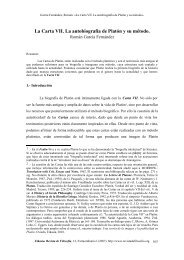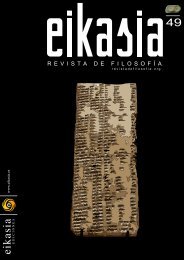Descargar número completo (4,15 MB) - Eikasia
Descargar número completo (4,15 MB) - Eikasia
Descargar número completo (4,15 MB) - Eikasia
You also want an ePaper? Increase the reach of your titles
YUMPU automatically turns print PDFs into web optimized ePapers that Google loves.
A topological model for consciousness: the four original forms of consciousness | Fernando Miguel Pérez Herranz<br />
The four actants that make up the morphology can be reduced by a<br />
smooth transformation to a maximum (the same applies to the<br />
hyperbolic umbilical). The question is whether one of the actants<br />
is interpreted as Subject or Instrument. I refer to Thom's<br />
interpretation of the indirect Messenger.<br />
3) Thirdly, I will establish a wider philosophical hypothesis:<br />
original consciousness is plural, because there are, at least, four<br />
ways to make contact with the two (self) consciousnesses that<br />
block the resonance between the Subject and Instrument actants.<br />
This hypothesis spans from topological to neurological<br />
hermeneutics, via semantic hermeneutics according to the Thom-<br />
Petitot-Wildgen rule.<br />
Topological hermeneutics:<br />
The Elliptical umbilical, models the states of excitement, tension,<br />
and its opposite, resistance: E1: morphologies of tension and<br />
penetration. E2: The opposite, the morphology of resistance (cf.<br />
SSyM, 112, 207).<br />
The Hyperbolic umbilical models the states of inhibition,<br />
expulsion and relaxation. H1: the morphology of expulsion. H2:<br />
The opposite, the morphology of relaxation, of the vault (la voûte).<br />
Neuronal Hermeneutics. The consciousness appears. This purely<br />
topological approach, can be read now as a morphological field in<br />
which two recurrent dynamic systems interact, whose product A<br />
B is structurally unstable (two sets of attractors which collide<br />
and remain in a state of imbalance with respect to each other).<br />
This phenomenon is known as resonance (SSyM, 145). Thus the<br />
traditional model of consciousness (Crick, Korch ...) is displaced<br />
as the transition from the waking to the sleeping states and vice<br />
versa (the process of hysteresis) in favour of resonance or collision<br />
between two dynamic systems. Therefore we can now speak of<br />
"communicating brains".<br />
object using instrument I, emanation of the subject, it is necessary<br />
to collapse the area between the instrument and the object, M, the<br />
mediator of the subject. This is the consciousness of the excluded<br />
party.<br />
H.2. If this part resists, M is protected by the other three actants.<br />
This is the all-encompassing and protective consciousness of the<br />
other actants. (Fig. 4).<br />
Fig. 4. The four original forms of consciousness with their<br />
opposites<br />
The four original forms of consciousness<br />
E. Elliptical consciousness-Instrumental<br />
E.1. A consciousness that affirms its status as the sole Subject and<br />
everything else - including the Other Subject-, appears to it as<br />
Messengers/Instruments. The Messenger/Instrument actant<br />
identifies with the Other that is not the Subject.<br />
E.2. A consciousness that resists becoming the Instrument and in<br />
turn affirms itself to be the sole Subject. The Instrument blends<br />
with the Subject.<br />
H. Hyperbolic consciousness - Corporal<br />
H.1. A consciousness of the subject that begins to stabilize by<br />
absorbing the element that is blocking it. In order to capture the<br />
168<br />
MARZO<br />
2012


